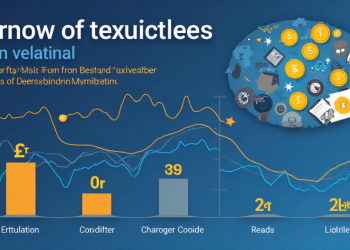In the dynamic world of cryptocurrency, Bitcoin dominance stands as a pivotal metric, reflecting Bitcoin’s market capitalization relative to the entire crypto market. As of June 2025, Bitcoin holds approximately 63.94% of the total crypto market cap , a figure that has fluctuated significantly over the years, driven by technological advancements, regulatory shifts, and investor sentiment. This article delves into the historical trends, influencing factors, and future implications of Bitcoin dominance, offering actionable insights for investors and market observers.
What is Bitcoin Dominance and Why Does It Matter?
Bitcoin dominance, calculated as (Bitcoin Market Cap / Total Crypto Market Cap) × 100, serves as a barometer of market sentiment. A high dominance (e.g., above 60%) signals investor preference for Bitcoin as a “safe haven” asset, often during periods of uncertainty. Conversely, a decline in dominance suggests increased risk appetite, with capital flowing into alternative cryptocurrencies (altcoins) .
For instance, Bitcoin’s dominance surged to 74% in January 2021 amid institutional adoption and retail FOMO, only to drop to 39% by January 2022 during the bear market, as investors diversified into altcoins like Ethereum and Solana . This volatility underscores the metric’s role in identifying market cycles and guiding investment strategies.
Historical Trends: Bitcoin’s Rollercoaster Ride
Bitcoin’s dominance has evolved through distinct phases:
- Early Dominance (2009–2017): With no viable competitors, Bitcoin held >90% market share until 2017, when Ethereum’s ICO boom triggered a decline to 41% .
- Post-Bear Market Recovery (2018–2020): Dominance rebounded to 71% in 2020 as Bitcoin’s halving event and institutional interest fueled a bull run .
- Altcoin Resurgence (2021–2023): The rise of DeFi, NFTs, and meme coins drove dominance down to 39% in 2022, though it stabilized at 50% by 2023 .
- Institutional Era (2024–2025): Regulatory clarity (e.g., U.S. spot Bitcoin ETF approvals) and corporate adoption (e.g., MicroStrategy’s 1M+ BTC holdings) pushed dominance back to 63% in 2025 .
These trends highlight Bitcoin’s resilience and the cyclical nature of crypto markets, where dominance often peaks before altcoin seasons .
Factors Influencing Bitcoin Dominance
Bitcoin’s market share is shaped by a complex interplay of forces:
1. Institutional Adoption
In 2025, institutional capital flows into Bitcoin are projected to exceed $400 billion by 2026, driven by sovereign entities (e.g., U.S. states converting seized assets into Bitcoin reserves) and corporations like MicroStrategy . This influx strengthens Bitcoin’s liquidity and perceived stability, reinforcing its dominance.
2. Regulatory Environment
Favorable policies, such as the U.S. SEC’s approval of spot Bitcoin ETFs, attract mainstream investors, while bans (e.g., China’s mining restrictions) can disrupt supply and impact prices . Regulatory clarity in 2024–2025 has reduced uncertainty, boosting Bitcoin’s appeal.
3. Technological Advancements
Bitcoin’s scalability solutions (e.g., Lightning Network) and security innovations (e.g., Taproot upgrade) enhance its utility, while competing blockchains (e.g., Ethereum’s Merge) threaten to divert capital. However, Bitcoin’s role as digital gold remains unchallenged .
4. Market Sentiment
During bull markets, Bitcoin often leads the charge, but altcoins outperform during corrections. For example, in late 2024, Bitcoin’s price consolidation near $98,000 triggered a shift toward altcoins, with the Total 3 index (ex-BTC/ETH) entering a “price discovery” phase .

Bitcoin Dominance vs. Altcoins: A Symbiotic Relationship
While Bitcoin’s dominance and altcoin performance are often seen as inversely correlated, they share a symbiotic dynamic:
- Bitcoin’s Strength: A rising Bitcoin market cap often expands the total crypto market, benefiting altcoins indirectly.
- Altcoin Innovation: Breakthroughs in DeFi, Web3, and AI-driven tokens (e.g., Ethereum’s Layer 2 solutions, Cardano’s smart contracts) attract new users, diversifying the ecosystem .
However, altcoin seasons typically follow Bitcoin’s consolidation phases. For instance, in early 2025, Bitcoin’s dominance breakdown below 64% signaled a potential alt season, with analysts predicting altcoins could outperform Bitcoin by 20–30% .
Current State and Future Outlook
As of June 2025, Bitcoin trades near $97,900, testing the 4-hour 200 MA at $98,139 . A sustained breakout above $100,000 could push dominance toward 70%, mirroring 2021’s highs. Conversely, a drop below $95,881 (4-hour EMA) might trigger a correction, favoring altcoins .
Long-term, institutional adoption and Bitcoin’s scarcity (21 million cap) are tailwinds, but competition from altcoins and macroeconomic factors (e.g., interest rates) pose risks. Analysts at Bitwise Asset Management predict Bitcoin will enter a “new era of institutional dominance,” with sovereign reserves and corporate treasuries driving demand .
Conclusion: Navigating the Crypto Market with Bitcoin Dominance
Bitcoin dominance is more than a statistic—it’s a lens into market psychology, institutional behavior, and technological innovation. As Bitcoin balances its role as digital gold and a speculative asset, investors must monitor its dominance alongside altcoin trends to capitalize on opportunities.
Stay ahead with OKHTX’s real-time market insights and expert analysis, empowering you to make informed decisions in a rapidly evolving landscape. Whether Bitcoin’s dominance rises to new heights or gives way to altcoin innovation, OKHTX equips traders with the tools to navigate volatility and seize growth.
Unlock the future of crypto trading—visit OKHTX today.
















